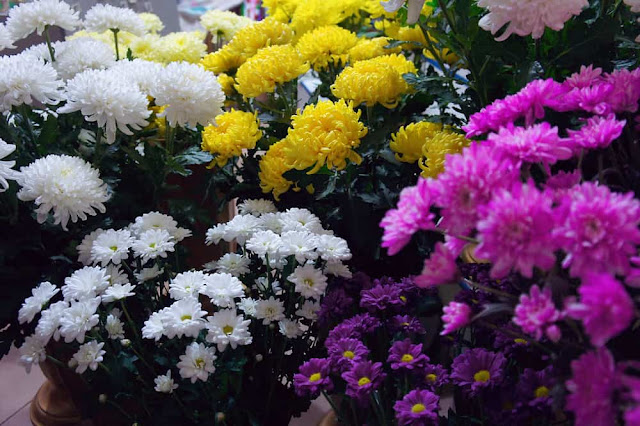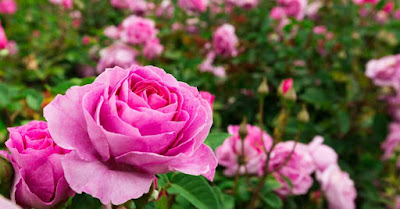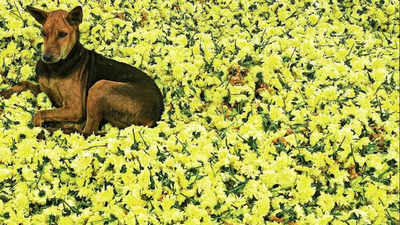Chrysanthemum
Plants
Chrysanthemums, sometimes called mums or chrysanths, are flowering plants of the genus Chrysanthemum in the family Asteraceae. They are native to East Asia and northeastern Europe. Most species originate from East Asia and the center of diversity is in China. Countless horticultural varieties and cultivars exist.
13 Different Types of Chrysanthemums (Plus Planting Tips and Health Benefits)
Chrysanthemum flowers are the second in the world, next to rose. There are 40 wild species and thousands of varieties of chrysanthemums. The varieties can differ in size, colors and number of flowers per stem.
A study conducted by NASA revealed that chrystanthemums also help reduce air pollution. Get to know the 13 different types of chrystanthemums and this flower’s health benefits.
Types
Single blooms
These chrysanthemums look very much like daisies, thanks to their white petals and yellow centers. The main difference is that the centers are a little larger than they are in daisies, and their petals are spaced equally all around them. When they grow, chrysanthemums have a bushy-like quality, and they usually grow 2-3 feet high, although some of the smaller varieties never reach a foot. Sometimes there is one petal per stem, while at other times there can be single-bloom plants that grow in clusters. Some of the varieties include Icy Isle, which looks just like the yellow-and-white daisy, and the Fire Island, which consists of a yellow center and red petals that have yellow stripes. There is also a semi-double type of mum, which is very similar to the single blooms and are attractive when used in sprays. Examples: Daisy, Tenderness, and Amber Morning.
Quilled blooms
Spider blooms
These chrysanthemums have petals that are long and thin and look a lot like spider legs. Even though they’re long and tubular, the petals often go off in all different directions, looking lacy and elegant. One of its varieties, Evening Glow, has petals that are rose to bronze in color, while the Symphony is lacy and bronze to yellow in color. Some varieties are white in color. Another variety, the Chesapeake, is at least 6 inches high and has petals that range from very fine to coarse. Spider blooms can also have petals that hook or coil at the tips. Example: Cremon and Anastasia.
Anemone
These flowers have a central disk with petals surrounding themselves around that disk, with the exception that these petals are tubular in shape and create a cushioned appearance. The variety called Angel is striking because it has a yellow center and small lavender-colored petals that create the cushion, as well as outer petals that are somewhat larger and are usually colored in dark purple with white tips. With a raised cushion-like center, the Anemone mums are perfect as a disbud and grow at least 4 inches high. Examples: Daybreak and Mansetta Sunset.
Pompons
Called Pompons – not Pompoms – these chrysanthemums’ heads are globe-shaped and have short petals that hide their disk. If they are small, they are called button mums. The Moonbeam variety has blooms that are large and solid-white in color, while the Yoko Ono has very small blooms, usually very green in color. The Moonbeam variety can grow up to 2 or 3 feet in height. The Pompons start out flat but turn quite round when they mature, and the blooms can be 4 inches wide. One example is the Lakeside, which grows 1-4 inches high. Pompons are perfect for use in sprays. Examples: Baby Tears and Small Wonder.
Decorative blooms
Reflex and Incurve blooms
The petals of these types of chrysanthemum either curve inward or outward, hence the name. The ones that incurve irregularly have large heads and irregular-shaped petals, so they look slightly inconsistent and very informal. The variety called Goldfield is an example of this type of chrysanthemum, and they are golden yellow in color. Most irregular or incurve mums grow to 6-8 inches in height. A more formal type consists of regular incurves, and these flowers are more uniform-looking and more formal. The latter is also more ball-like and compact, making it especially attractive to many mum-lovers. These tend to grow no more than 6 inches high. The variety called Moira is mauve and lavender in color. The chrysanthemums known as intermediate curve mums have a small, fluffy-looking flower, while the St. Tropez – a French variety – has bright red petals and bronze-colored tips. Finally, reflex mums have petals that droop away from the center of the plant, such as the Joyce Fountain. This variety has gorgeous red petals with a touch of yellow in the center. These chrysanthemums can also have an intermediate incurve. In these flowers, there are shorter petals than the irregular incurve mums, and they usually grow at least 6 inches high. One example of the intermediate incurve mum is called the Bob Dear, which is bright yellow in color and quite stunning.
Reflex mums
These chrysanthemums have flat centers and over-lapping petals that curve downward. The globe-shaped blooms are approximately 4-5 inches wide and are likely to be light or dark orange in color, although other colors are possible. Reflex mums grow up to 6 inches high and have full and flat blooms. Their darker colors, such as deep orange and red, are nothing short of striking.
Brush or Thistle Chrysanthemums
These mums have tubular petals that are fine and grow parallel to the stem. They usually grow no more than 2 inches in diameter, and the petals can be flat, drooping, or even twisted, looking just like a paint brush in some instances. They are good for use in sprays and are very small – no more than 2 inches high.
Unclassified
As the name suggests, these are mums that do not fit neatly in any other category. They are usually 6 inches or wider, or the petals are exotic and large and resemble other types of mums. They can also have twisted petals on them. The Lone Star is an example of an exotic plant, and it grows at least 6 inches high.
Spoon mums
These are almost identical to the semi-double mums, except the petals look like spoons at the tip of the petal. With a center disk that is visible and round, varieties such as the Kimie grow at least 4 inches in height and make an excellent addition to any spray or as a disbud. Examples: Happy Face and Starlet.
Cushion mums
These mums are quite bushy and grow low to the ground. They produce wide masses of blooms that are medium in size. Examples: Valor, Chiffon, and Ruby Mound.
Miscellaneous mums
- Red Bradford: Paprika red to deep burgundy.
- Football mums: Found in nurseries during the Fall months.
- Daisy mum: Usually multi-colored and look like daisies.
- Dark Weldon: A beautiful mix of soft yellow and lilac.
- Focus: Bright yellow highlighted in green in the center.
- Orange Viking: A bronze-orange color.
- Yellow Sizzle: Colored in yellow and dark orange.
What Not to Do When Planting Mums
When planting mums, be sure you don’t:
- Plant mums that were placed in a pot and given to you as a gift. Instead, look for plants that are grown in nurseries and ready to be planted the right way.
- Forget to feed your mums. Mums love to eat, so feed, feed, feed!
- Expect them to be sturdy and healthy if they are planted in containers. This is because when mums are in containers, their roots aren’t as protected as they should be, which means you should treat them as annuals and re-plant them the following year.
- Forget to pinch your mums. At six inches high and again at 12 inches, pinch off the branches’ tips in order to keep them more compact and skip that messy stage that happens right before their blooms open up to the world.
- Forget to take advantage of the mums you already have in your flower bed. If you plant mums in the spring like you do your other perennials, the wait will be well worth it once they start to bloom.
The Many Health Benefits of Chrysanthemums
Drinking a tea made with the flowers of the chrysanthemum plant offers relief for a variety of ailments, including:
- Tinnitus
- Colds
- Sore throats
- Headaches
- Eyes that are inflamed
- Vertigo
- Skin conditions such as boils
- Anxiety
- Tightening of the chest
- Allergies
- Hypertension (high blood pressurer
How to Make the Tea
Simply place a fair amount of the flowers in a closed vessel filled with hot water and let it steep for approximately 10 minutes. Producing the tea in a closed pot or pan allows you to preserve the essential oil that results. Of course, if you find chrysanthemum in capsule form, all you have to do is follow the directions on the bottle and take them according to these instructions.
Medicinal Properties in Chrysanthemums
These include being anti-bacterial, anti-inflammatory, demulcent, febrifuge, hepatic, aromatic, refrigerant, and hypotensive.
Ingredients in Chrysanthemums
Some of the helpful ingredients found in mums include calcium, beta-carotene, magnesium, potassium, ascorbic acid, essential oils, fiber, iron, Vitamin C, riboflavin, niacin, and folacin.
Chrysanthemum Tea Can
- Help you feel better without the nasty side effects that other medicines may have, particularly prescription medications. For instance, tea made with chrysanthemums have no caffeine, so you won’t suffer with nervousness, anxiety, or tension.
- Lower your body temperature, which is just what you need when running a fever or have problems with your sinuses or even heat stroke. Even if you have a toothache or pain in your gums, chrysanthemum tea can help you relieve your pain.
- Help alleviate pimples, acne, and other skin problems.
- Detoxify your liver, making you healthier overall, as well as lower your cholesterol numbers.
- Rejuvenate the brain and alert the senses. This is because chrysanthemum tea stimulates all of your senses while, at the same time, calming your nerves.
- Help alleviate dryness and itchiness in the eyes.
- Help ease digestive issues, eliminating a lot of your digestive problems and keeping you in less pain with fewer stomach problems.
- Help alleviate varicose veins.
- Help unclog arteries and improve your overall heart health.
- Boost your immune system because of its high levels of Vitamin C and Vitamin A.
- Help improve bone density and even prevent osteoporosis. This is due to its many naturally occurring minerals, including calcium and magnesium.
- Improve your vision. In addition to uncomfortable or inflamed eyes, chrysanthemum tea can also improve your eyesight, and can even protect against diseases such as cataracts, macular degeneration, neuropathy, and even blurry vision.
- Prevent certain chronic illnesses, in part because it helps fight free radicals, prevents cellular mutations, and protects you against numerous illnesses caused by these free radicals.
- Increase your metabolism, which can help you lose weight, improve circulation, regulate hormone levels, and even improve neurotransmitter activity.
A Few Words of Caution
Like other herbs and natural remedies, no one should consume chrysanthemum tea without first speaking to a qualified physician, especially if you already take prescriptions or have any medical conditions. Although there are no known side effects even for people taking other treatments, it is safer all around to check everything out with a medical professional before drinking chrysanthemum tea or taking the capsules. This will ensure that nothing goes wrong while you’re drinking the tea, giving you the peace of mind you deserve.





















I read your blog on different flowers category that is very unique information sharing with us .Thank you for sharing information on flowers.
ReplyDeleteflower shop in manila